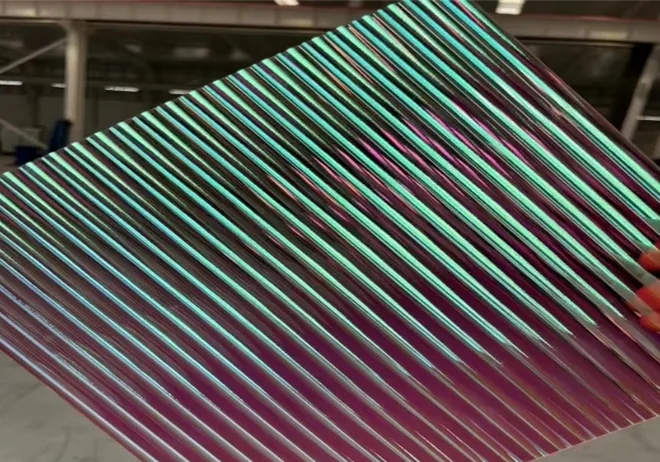Dec . 10, 2024 08:45 Back to list
what does laminated glass mean
Understanding Laminated Glass Definition, Benefits, and Applications
Laminated glass is a remarkable invention in the field of material science and architecture, combining aesthetic appeal with durability and safety. By definition, laminated glass consists of two or more layers of glass that are bonded together with an interlayer, typically made of polyvinyl butyral (PVB). This process not only enhances the physical properties of the glass but also improves its performance in various applications, making it an increasingly popular choice in both residential and commercial buildings.
What is Laminated Glass?
Laminated glass is produced through a process involving the heating and pressing of sheets of glass around a polymer interlayer. The interlayer is crucial as it holds the sheets of glass together, even when shattered. This characteristic makes laminated glass an excellent choice for safety and security applications. In essence, if the glass is broken, the shards will adhere to the interlayer rather than falling freely, reducing the risk of injury from sharp glass pieces.
One of the most notable features of laminated glass is its ability to minimize ultraviolet (UV) radiation. The PVB interlayer blocks a significant percentage of harmful UV rays, which helps to protect interior furnishings and reduces fading. This quality makes laminated glass a popular choice for windows and doors in homes, offices, and other buildings where sunlight exposure can lead to deterioration of materials.
Benefits of Laminated Glass
1. Safety and Security One of the most significant advantages of laminated glass is its safety features. The glass remains intact even when broken, greatly minimizing the risk of injuries from flying shards. This makes it an ideal choice for environments where safety is a concern, such as schools, hospitals, and public buildings. Additionally, the strong bonding layer provides an additional barrier against break-ins, improving security.
2. Sound Insulation Laminated glass also exhibits excellent soundproofing qualities. The interlayer helps to absorb sound vibrations, making it an ideal solution for noise-sensitive environments such as offices located in busy urban areas or residential areas near airports or highways. By using laminated glass, occupants can enjoy a quieter, more serene environment.
what does laminated glass mean

3. UV Protection As mentioned earlier, laminated glass effectively blocks harmful UV rays. This characteristic is particularly beneficial for homes and businesses, as it helps protect furniture, artwork, and textiles from fading. This added layer of protection enhances the longevity of interior decor and reduces replacement costs over time.
4. Aesthetic Appeal Laminated glass is available in various designs, colors, and finishes, allowing for a high degree of customization. Architects and designers are increasingly incorporating laminated glass into their projects, as it can enhance a structure's aesthetic appeal while also providing functional benefits. From frosted finishes to tinted glass, the design possibilities are virtually endless.
5. Energy Efficiency Laminated glass can contribute to energy efficiency in buildings. By using multiple layers of glass, along with low-emissivity (Low-E) coatings, laminated glass can help regulate indoor temperatures, leading to reduced heating and cooling costs. This feature is especially valuable in climates with extreme temperature variations.
Applications of Laminated Glass
Due to its numerous benefits, laminated glass is widely used in various applications. Some common uses include
- Windows and Doors Laminated glass is commonly used for residential and commercial windows and doors, providing safety, sound insulation, and UV protection. - Skylights and Canopies The strength and durability of laminated glass make it an excellent choice for skylights and canopies, allowing for natural light without compromising safety. - Auto Glass Laminated glass is also utilized in the automotive industry for windshields, providing structural integrity, safety, and reduced noise. - Interior Partitions In modern office designs, laminated glass is often used for interior partitions to create a sense of openness while still providing safety and sound control.
Conclusion
Laminated glass represents a significant advancement in glass technology, offering a combination of safety, aesthetic appeal, and performance. Its multiple layers of protection, sound insulation capabilities, and UV filtering properties make it a preferred choice for various applications. As architects and builders continue to seek materials that marry style with functionality, laminated glass will undoubtedly play a pivotal role in the future of architectural design. Whether for residential or commercial use, the advantages of laminated glass are clear, securing its place as a cornerstone in modern construction.
-
Safety and Style with Premium Laminated Glass Solutions
NewsJun.24,2025
-
Reinvents Security with Premium Wired Glass
NewsJun.24,2025
-
Premium Float Glass Line for Modern Architecture
NewsJun.24,2025
-
Low Emissivity Glass for Energy-Efficient Architecture
NewsJun.24,2025
-
High-Performance Insulated Glass Solutions for Modern Architecture
NewsJun.24,2025
-
Elevates Interior Style with Premium Silver Mirror
NewsJun.24,2025
Related PRODUCTS














